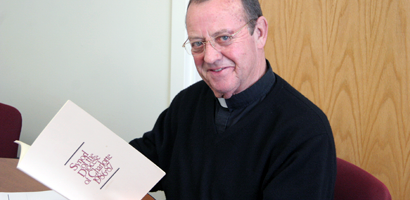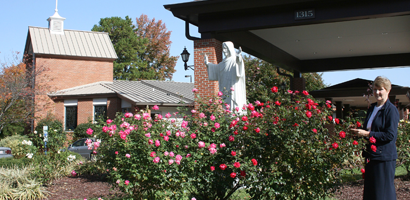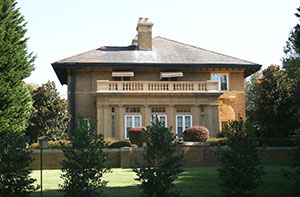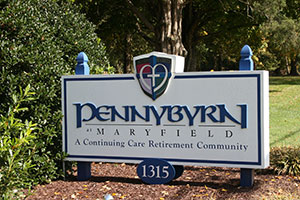 CHARLOTTE — A little-known fact to most Catholics now living in western North Carolina is that in 1987, the Diocese of Charlotte's second bishop, Bishop John F. Donoghue, gathered lay men and women, religious and clergy from across the diocese for a diocesan synod to address the issues facing the growing Church within this missionary territory. It was the first and so far only synod in the diocese's history, and its effects continue to be seen 25 years later.
CHARLOTTE — A little-known fact to most Catholics now living in western North Carolina is that in 1987, the Diocese of Charlotte's second bishop, Bishop John F. Donoghue, gathered lay men and women, religious and clergy from across the diocese for a diocesan synod to address the issues facing the growing Church within this missionary territory. It was the first and so far only synod in the diocese's history, and its effects continue to be seen 25 years later.
What is a synod?
By definition, a synod is an assembly of ecclesiastics or other Church delegates, convoked pursuant to the law of the Church, for the discussion and decision of ecclesiastical affairs; an ecclesiastical council.
Why hold a synod?
In his letter to the people of the diocese on Sept. 14, 1985, Bishop Donoghue said, "It is my hope that in the broad consultation called for by a Synod, we will be able to develop a pastoral plan which will shape the diocese for the future so that together, we will be the 'sign and instrument of communion with God and unity among all men'." (Vatican II, "Constitution of the Church")
When did the diocesan synod take place?
From October of 1985 until the first meeting of the synod in September 1986, Bishop Donoghue established preparatory commissions, held parish programs during Lent to address the synod issues to be discussed, selected members to attend the synod, and created materials to be considered at the synod.
After the first meeting of the synod in September 1986, the preparatory commission revised the materials. The second session of the synod was held in January 1987. The materials were then revised a second time. The final session of the synod was held in May 1987. The synod documents were promulgated, or published, at that time and the implementation of the diocesan pastoral plan established by the synod then began.
In all, more than 140 people from around the diocese contributed their time and talents to the synod.
In his letter of promulgation on May 23, 1987, Bishop Donoghue noted, "Through this Synod, we have grown together as a community of faith. We have supported one another as a community of love; and we have served one another and our brothers and sisters throughout the Diocese of Charlotte, out of a conviction of faith and an experience of God's Spirit at work within us.
"The sole task of this Synod has been to glorify the Lord through the advancing of His Kingdom in this Diocese, at this time, through the men and women who are now providentially the People of God of the Diocese of Charlotte. I am confident that what we propose for implementation will lead each of us and all members of the Church of Charlotte to be mindful of the need for personal and ecclesial purification and the need to reach out and truly be a 'light to the nations.'"
What was the outcome of the 1987 synod?
Seven areas were addressed during the synod that saw direct results afterward. The areas were: spiritual life, evangelization, education, poverty, lay ministry, councils and growth.
Monsignor John J. McSweeney, the first priest ordained for the Diocese of Charlotte and now pastor of St. Matthew Church in south Charlotte, was vicar general and chancellor of the diocese during the time of the synod.
Monsignor McSweeney stresses that those seven areas were carefully selected, and great effort went into selecting Catholics from around the diocese to participate in the synod and discuss these topics.
"At that time we had no idea of the growth the diocese would experience," he noted. "We made sure we kept it balanced, as there are 46 counties in the diocese. We didn't want everything based or centered in Charlotte."
Monsignor McSweeney believes the 1987 Diocesan Synod is historically significant for many reasons, which can be seen in the fruits of the synod still tangible today. In particular, he has witnessed a great impact in the areas of Catholic schools, lay ministry, Catholic Social Services and the work of pastoral councils in the local parishes.
"At the time of the synod, there was a bold effort to save Catholic schools, to make sure there was equity in pay (for teachers), to build Catholic identity, merge schools and build new ones," he said.
He said he is impressed with the response of the laity and the development of lay ministry in the diocese over the past 25 years. His parish is a prime example of this growth, as the 9,000 registered families there can participate in more than 100 ministries. Every parish in the diocese has a range of ministries for the laity according to the seven topics the synod focused on.
Thinking back to the time of the synod, Monsignor McSweeney said, "What amazed me so much was all these people giving their time – seriously giving their time."
— SueAnn Howell, senior reporter
Did you know?
As the shepherd of the Diocese of Charlotte, the bishop regularly issues pastoral letters and other official communication about and for the local Church in western North Carolina.
Since the diocese was founded in 1972, many official documents have been promulgated, or decreed, by its four successive bishops. These decrees provide clarification, direction and focus to the clergy, religious and laity around western North Carolina.
Here are some of the major documents and pastoral letters promulgated by the bishops over the past 40 years:
1975 "This Land is Home to Me" – A pastoral letter by Bishop Michael J. Begley, the diocese's first bishop, written as a statement of solidarity with the poor and powerless in Appalachia
1987 "Synod Promulgation" – A promulgated document by Bishop John F. Donoghue, the diocese's second bishop, outlining the goals and action plans that emerged from the landmark Diocesan Synod in 1987
1997 "Of One Heart and Mind" – A pastoral letter issued jointly by Bishop William G. Curlin (the diocese's third bishop) and Raleigh Bishop F. Joseph Gossman, discussing the disparities in economic opportunities across North Carolina
2004 "Worthy to Receive the Lamb: Catholics in Political Life and the Reception of Holy Communion" – A joint pastoral letter by Atlanta Archbishop John F. Donoghue, Charleston Bishop Robert J. Baker and Bishop Peter J. Jugis, written to guide Catholics in public life regarding their responsibilities and the reception of Holy Communion
2005 "Liturgical Norms" – A promulgated document by Bishop Peter J. Jugis outlining the liturgical norms for the celebration of the Sacred Liturgy in the Diocese of Charlotte
2007 "Guiding the Roles of Pastors and Pastoral Councils" – A promulgated document explaining the respective roles and responsibilities of the parish, the pastor, the parish's pastoral and finance councils, and the parish's commissions or committees
— compiled by SueAnn Howell, senior reporter

HIGH POINT — Pennybyrn at Maryfield is celebrating 65 years of caring and compassion this week, marking the day in 1947 when the retirement and assisted living community was founded in High Point by five women religious.
On Nov. 14, 1947, five Sisters of the Poor Servants of the Mother of God were sent by their congregation in London, England, to High Point to start a mission at the request of North Carolina Bishop Vincent Waters. The congregation purchased Penny House, originally built by George Penny in 1927, on Greensboro Road in High Point. The sisters lived there and opened a convalescent center with 22 beds. It became known as Maryfield after it was licensed as a nursing home in the 1950s.
Sixty-five years since the first sisters arrived, Maryfield has grown into a 71-acre continuing care retirement community called Pennybyrn at Maryfield. The facilities, which were entirely rebuilt in 2007, include a small neighborhood of 20 independent living cottages, a building of 131 independent living apartments, a building of 24 assisted living and 24 memory support apartments and a newly-renovated nursing care building. The front of the chapel houses Perpetual Eucharistic Adoration, in which 200 volunteers from all across the Triad take turns keeping vigil.
Five Sisters of the Poor Servants of the Mother of God still reside in Penny House, but the nursing home moved to a separate building behind the house in 1965. The community now has a total of 325 residents and 385 staff. The sisters continue in the tradition of their founder, Frances Taylor, who took the name of Mother Magdalen, taking care of their residents with the help and guidance of a board of directors and ambassador council comprised of people from the surrounding area.
 Over the years as the needs of the community have grown, the sisters' dedication to caring has evolved into a new, vibrant retirement lifestyle and care for people of all faiths.
Over the years as the needs of the community have grown, the sisters' dedication to caring has evolved into a new, vibrant retirement lifestyle and care for people of all faiths.
The chairman of the board, Sister Lucy Hennessy, SMG, who is originally from Limerick, Ireland, notes that "people of all faiths have helped and are being served here and taken care of here."
Pennybyrn "goes to the heart of our mission helping anyone in need and making life better for others," Sister Lucy said.
"Respect, compassion and care are Pennybyrn's foundation; the sisters who first came to America were on a mission to care for others and to create an environment of true hospitality; welcoming all and helping each person feel at home," said Pennybyrn at Maryfield President and Community Leader Rich Newman.
 Sister Lucy noted, "On this the celebration of our 65th anniversary, the sisters look back with deep gratitude to God and to all those who contributed in so many ways to the growth and survival of this great mission. In our hearts we know that this mission has been both handmade and hand held by our loving God."
Sister Lucy noted, "On this the celebration of our 65th anniversary, the sisters look back with deep gratitude to God and to all those who contributed in so many ways to the growth and survival of this great mission. In our hearts we know that this mission has been both handmade and hand held by our loving God."
— Kathy Roach, correspondent. Photos by Kathy Roach and provided by Pennybyrn at Maryfield
Reflection about the 65th anniversary of the founding of Pennybyrn at Maryfield
Looking back on the years since the founding of Pennybyrn at Maryfield, it is worth recording how simple, but yet challenging the first year of this 65-year journey truly was. Due to poor economic conditions in the local area at the time, the Sisters' original plan to open a hospital would not happen. Instead, it was God's plan that the Sisters' refocus their mission to caring for elders.
It all begin in 1947 when a special invitation was extended by Bishop Vincent Waters of the Raleigh Diocese to the leadership team of our congregation, the Poor Servants of the Mother of God in London, England. The invitation was to come and open a mission here in North Carolina. After some discussion among the leaders of the SMG community, it was decided that America indeed was a country in which the SMG spirit and values of our foundress, Magdalen Taylor would grow and develop.
The congregation chose five sisters to bring their mission to High Point. The sisters arrived here on Nov. 14, 1947, and were led by Sister Patrice, a woman of great vision and determination. She faced many challenges, but with faith and trust in God, along with the firm commitment of the other four sisters, she steered ahead. Those four sisters – Sister Anne Christina, Sister Mary Benignus, Sister Assumption and Sister Mary Monica – put their gifts and talents wholeheartly behind the wonderful vision of founding a mission to serve the needs of the sick, the elderly and anyone else who could not help themselves.
Immediately upon the sisters' arrival, they took up residence in the Penny House, which was built in 1927 by George Penny and his wife Lena of Greensboro. Shortly thereafter, in January 1948, the sisters opened the house as a convalescence/rehab home, which became known as Pennybyrn Convalescence Home where care was eventually given to approximately 22 residents. In the early 1950s, it was licensed as a nursing home and from that point on it would be known as Maryfield.
During all these years the sisters faithfully carried out the mission of Maryfield, which is "to demonstrate God's love for those whose lives we touch." They did this by serving the residents with compassion and kindness and all for the greater glory of God.
Once the people of the Triad saw the strong sense of mission and determination that the sisters displayed, they went all out to support them in whatever way they could. Assistance came in the form of moral support, financial support and in many other ways to make their vision possible.
Gradually, the sisters could see that residents coming to them for help were frailer and had greater needs. It became evident that life for these residents would be better served in a building more suited for such care.
In the early part of the 1960s, plans were drawn up for a nursing home and in 1965 residents moved out of the Penny House and into a new nursing home located on property directly behind the Penny House. As various needs arose over the next several decades, the sisters continued expanding their services to meet those needs.
During these periods of expansion, the sisters sought the assistance of many of the area's leaders and it is these individuals and others that have made Pennybyrn at Maryfield what it is today. For example, our Board of Directors and the Ambassador Council was born out of the need for community guidance, support and leadership. Along with the sisters, people of all faiths have served God by giving of themselves and through their financial support.
Another very important group of people that grew with us throughout the decades and who are now a part of the fabric of Pennybyrn at Maryfield is our staff. We are proud of their commitment, and of our tremendous leadership team.
Since those early days, Pennybyrn at Maryfield has since grown into a continuing care retirement community situated on 71 beautiful acres nestled on a cove on City Lake. Currently, more than 325 residents call Pennybyrn at Maryfield home.
On this the celebration of our 65th anniversary, the sisters look back with deep gratitude to God and to all those who contributed in so many ways to the growth and survival of this great mission. In our hearts we know that this mission has been both handmade and hand held by our loving God.
— Sr. Lucy Hennessy, SMG, Mission Leader

